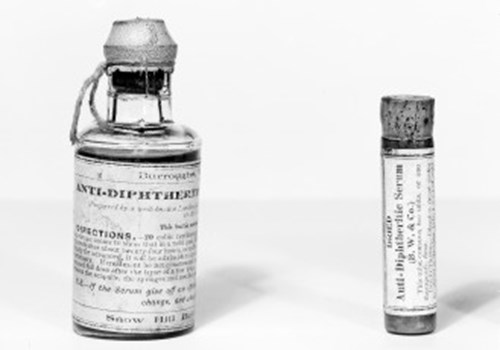Toxigenic Corynebacterium species: Building a modern bio-resource to counter an old disease

Corynebacterium diphtheriae is the principal cause of diphtheria, an acute infectious disease that follows infection of mucosal membranes (such as the throat or nose) or wounds by a toxin-producing (toxigenic) strain of C.diphtheria which can prove fatal if not treated. Toxigenic Corynebacterium ulcerans can also cause diphtheria or a diphtheria-like illness, as can toxigenic Corynebacterium pseudotuberculosis, albeit much more rarely.
With the support of Public Health England’s Respiratory and Vaccine Preventable Bacteria Reference Unit (WHO Collaborating Centre for Diphtheria and Streptococcal Infections1), NCTC is currently reviewing the identity and toxigenic status of the Corynebacterium strains held by the collection. The tests include molecular methods such as PCR to detect the diphtheria toxin gene, and a phenotypic test to confirm toxin production such as the ELEK test2. Not all strains of C.diphtheriae, C.ulcerans or C.pseudotuberculosis carry the gene required for producing the diphtheria toxin, and those that do so may not always be phenotypically toxigenic3. This work is providing comprehensive and contemporary identification and phenotypic toxin data, including specification of C.diphtheriae biovar, and will be continuously added to the NCTC online catalogue over the coming months.
Antibiotics to treat infection, the diphtheria antitoxin (DAT) and an effective vaccine are all available, leading to a decrease in the number of cases of diphtheria in the developed world4. However, high rates of vaccination need to be maintained to ensure protection from diphtheria and there is still a need for adequate expertise in diagnostic laboratories. In July this year, the European Centre for Disease Control (ECDC) released a technical report calling for enhanced diphtheria diagnostic capacity and surveillance capacity in EU laboratories5. Inaccuracy in toxigenicity testing and better availability of national and global guidelines for diphtheria diagnosis were cited specifically as requiring improvement, both areas in which the provision of well-characterised reference and control strains can play a part.
Over 150 strains of a variety of Corynebacterium species are available from NCTC including a biodiverse number of strains from within the three potentially toxigenic species, candidate strains for positive and negative controls for toxigenicity testing, and strains used historically for the production of diphtheria antitoxin, such as NCTC 4305.
NCTC has been specialising in the safe provision of bacterial strains for almost 100 years. Supply of authentic reference cultures and other biological materials with comprehensive identification and phenotypic toxin data is an essential part of supporting industry, promoting safety in research and the development of a robust global public health infrastructure.
References
- WHO Collaborating Centre for Diphtheria and Streptococcal Infections. Available from: http://apps.who.int/whocc/Detail.aspx?cc_ref=UNK-194&cc_code=unk [Accessed 01/08/2017]
- Public Health England. Bacteriology Reference Department User Manual. 11 April 2014. Updated 28 October 2015.
- Public Health England. Diphtheria: guidance, data and analysis. Laboratory isolates of C. diphtheriae and C. ulcerans 31 March 2014
- European Centre for Disease Prevention and Control. Factsheet about diphtheria.
- European Centre for Disease Prevention and Control. Gap analysis on securing diphtheria diagnostic. Available from: http://ecdc.europa.eu/sites/portal/files/documents/Diphtheria%20Gap%20Analysis%20final%20with%20cover%20for%20web.pdf [Accessed 01/08/2017]
